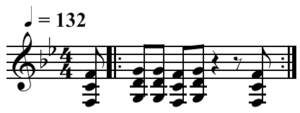Ostinato facts for kids

In music, an ostinato is a short musical pattern that repeats many times. The word "ostinato" comes from a word meaning obstinate or stubborn. Think of it as a musical idea that is stubborn and keeps coming back! You can say "ostinati" or "ostinatos" for the plural.
An ostinato can repeat for just part of a song. Sometimes, it might even last through the entire piece of music. It can be a group of notes that repeat, or it can be just a rhythm. It is a bit like a riff you hear in jazz music. Many types of music use ostinati, including classical music, jazz, boogie-woogie, and African music.
Contents
Types of Ostinato
Ground Bass: A Repeating Low Part
A special kind of ostinato is called a ground bass. It is also known as basso ostinato. This is a repeating pattern in the lowest musical notes. It keeps playing while the melodies above it change. This was very popular in baroque music. A famous example is the Canon in D by Johann Pachelbel. The bass line repeats over and over, creating a strong foundation for the other instruments.
Rhythmic Ostinato: A Repeating Beat
Sometimes, an ostinato is just a repeating rhythm. It does not have to be a specific set of notes. For example, the first part of the Planets Suite by Gustav Holst uses a rhythmic ostinato. This movement is called "Mars, the Bringer of War." It has a strong, repeating rhythm in 5/4 time. Another great example is Boléro by Maurice Ravel. This piece uses the same rhythm throughout the whole song.
Ostinato in Popular Music
Ostinati are also common in popular music. They help to make songs catchy and memorable. A good example is the song "Money" by Pink Floyd. It uses a repeating bass line and drum pattern. This creates a strong groove that you can easily recognize.
Related pages
Images for kids
See also
 In Spanish: Ostinato para niños
In Spanish: Ostinato para niños


